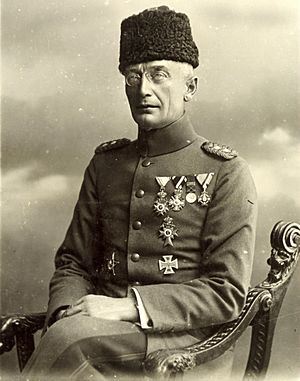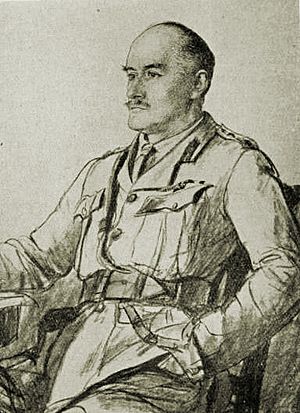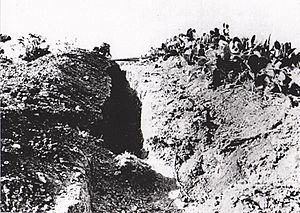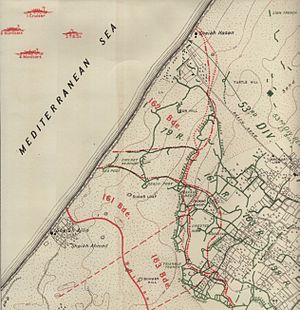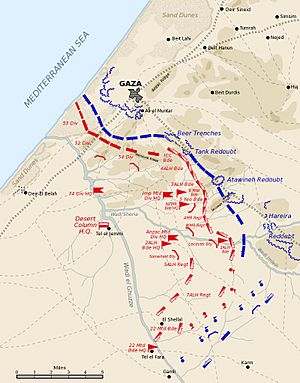Third Battle of Gaza facts for kids
Quick facts for kids Third Battle of Gaza |
|||||||
|---|---|---|---|---|---|---|---|
| Part of the Middle Eastern theatre of World War I | |||||||
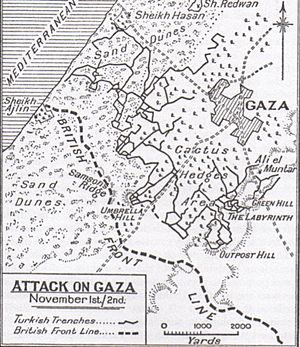 Map of Gaza with attacks on 1 and 2 November |
|||||||
|
|||||||
| Belligerents | |||||||
|
|
||||||
| Commanders and leaders | |||||||
| Units involved | |||||||
| XXI Corps | Eighth Army Yildirim Army Group |
||||||
| Strength | |||||||
| 10,000/35,913 | 4,500/8,000 | ||||||
| Casualties and losses | |||||||
| 2,696 | 1,000+ buried, 300 captured |
||||||
The Third Battle of Gaza was a major fight during World War I. It happened on the night of November 1–2, 1917. British and Ottoman (Turkish) forces fought near the city of Gaza in what is now Palestine.
This battle was part of a bigger plan by the British. They wanted to break through the strong defenses that the Ottoman army had built. The British had just won the Battle of Beersheba. This victory helped them end a long period where neither side could gain much ground. The Third Battle of Gaza, along with other attacks, finally broke the Ottoman defense line. This line stretched from Gaza to Beersheba. The Ottoman army had to leave Gaza on November 7, 1917.
Contents
Why Gaza Was Important
After two earlier battles for Gaza, the British and Ottoman armies were stuck. Neither side could advance much. Gaza itself was a very strong fortress. It had deep trenches, barbed wire, and good places for soldiers to watch and shoot from. These defenses stretched for many miles. They went from Gaza all the way to Beersheba.
In June 1917, General Edmund Allenby took over the British forces. He quickly reorganized his army. Both sides received more soldiers and supplies. They also trained their troops. By October, Allenby was ready to launch a new attack. He wanted to move his army more freely.
Gaza's Strong Defenses
Gaza was like a modern castle. It had strong trenches and lots of barbed wire. These defenses were especially tough on the south and southeast sides. There were many small forts, too. These forts could support each other with artillery, machine guns, and rifles. They made it very hard for an enemy to attack during the day.
The Ottoman army thought the British had more soldiers near Gaza than they actually did. However, the Ottoman commanders knew quite a bit about the British plans. They knew where some British camps were empty. They also knew where British divisions were moving.
After the British captured Beersheba, the Ottoman commanders were surprised. They sent more soldiers to defend the road to Hebron and Jerusalem. This road was very important. The British wanted to cut off the Ottoman armies. They wanted to stop supplies from reaching them.
Getting Ready for Battle
The British controlled the sea around Gaza. They used this to trick the Ottoman army. They spread rumors about landing troops from the sea behind Gaza. Ships were seen checking the water depth. Small boats gathered near Deir el Belah. On November 1, British workers pretended to get on boats. This made it look like a sea landing was happening.
At the same time, fierce fighting continued near Beersheba. This was part of the Battle of Tel el Khuweilfe. The British planned to attack Gaza as a trick. This attack would happen just before their main attacks on other Ottoman strongholds.
Who Was Fighting?
Ottoman Defenders
The Ottoman army defending Gaza was led by General Friedrich Freiherr Kress von Kressenstein. He had several divisions of soldiers. These soldiers had fought in earlier battles for Gaza. They were well-trained. They also had new machine guns. These guns made their army much stronger.
The Ottoman forces in Gaza had about 4,500 riflemen. They were supported by 116 artillery guns. They also had large naval guns. Two more divisions of soldiers were in reserve. This brought their total defenders to about 8,000.
British Attackers
The British Egyptian Expeditionary Force (EEF) was very large. It had over 100,000 fighting soldiers. This included cavalry, infantry, and artillery. General Allenby commanded this force.
The British XXI Corps was in charge of attacking Gaza. They had about 35,000 riflemen. These soldiers were from different divisions. Many of them had fought in earlier battles. They had experience fighting the Ottoman army. The British also had six Mark IV tanks. These tanks were new and powerful weapons.
British and Australian planes also helped. They flew over Ottoman lines. They took photos and bombed enemy positions. They also fought against Ottoman planes.
The Battle Begins
The British attack on Gaza was meant to keep the Ottoman soldiers busy. This would stop them from moving to other battle areas. The British had a huge advantage in artillery. They also used tanks.
Bombarding Gaza
The British artillery started shelling Gaza on October 27. The shelling became very intense. British and French navy ships also joined in. They fired their big guns from the sea. This was one of the heaviest bombardments of World War I outside of Europe. The British fired over 15,000 shells. They aimed at Ottoman batteries and other targets. They even used gas shells, but these did not seem to work well.
Night Attacks on November 1–2
The British XXI Corps attacked a 5,000-yard stretch of sandhills. These hills were southwest of Gaza. The attacks happened at night. This was because the Ottoman machine guns were too strong for daytime attacks.
Capturing Umbrella Hill
The first attack was on Umbrella Hill. This was a sand dune overlooking the main targets. British soldiers from the 52nd (Lowland) Division attacked at 11:00 PM on November 1. They quickly captured the hill. They killed many Ottoman defenders and took prisoners. They also captured machine guns. The British suffered few losses. However, the hill was hard to defend because the trenches were damaged by shelling.
Attacking El Arish Redoubt
The next attack began at 3:00 AM on November 2. The 52nd (Lowland) Division attacked the El Arish Redoubt. This was a strong line of trenches and forts. Two British tanks supported this attack.
British soldiers from the Royal Scots battalion fought through the Ottoman trenches. Six Ottoman mines exploded, causing some British casualties. The Ottoman army launched a strong counterattack. This pushed back some British soldiers. But more British troops arrived and held the position. Two tanks helped clear the way. One tank even laid barbed wire along the front line.
Pushing Through Coastal Defenses
While the Royal Scots fought, other British brigades attacked the western part of the El Arish Redoubt. The 54th (East Anglian) Division attacked with four tanks. They fought hand-to-hand in the trenches. They captured some trenches but had to pull back from others due to heavy fire.
On the left side, other British units got lost in the smoke and dust. Some attacked the wrong targets. However, the 1/6th Battalion, The Essex Regiment, successfully captured Beach and Sea Posts. They also attacked other trench systems. A tank helped by laying more barbed wire. Another tank helped capture Cricket Redoubt.
Advancing on November 2
The 1/10th Battalion, London Regiment, finished capturing the Rafa redoubt. They then captured Gun Hill. By 6:00 AM on November 2, they were ready to attack Sheikh Hasan. They captured it fifteen minutes later, taking many prisoners.
The British tried to capture Lion Trench to create a gap for their cavalry. But they were forced to retreat. Ottoman reinforcements tried to counterattack. However, British artillery and naval guns stopped them. The Ottoman batteries then pulled back.
The Third Battle of Gaza was not meant to capture the city itself. It was a trick to keep the Ottoman soldiers busy. This allowed the British to capture Beersheba. The British used new tactics, tanks, and a lot of artillery. They caused heavy losses to the Ottoman army. They captured many prisoners and weapons. The British advanced about 2 miles on a wide front. They held their new positions against Ottoman counterattacks. The British lost about 350 killed, 350 missing, and 2,000 wounded.
After the Battle
November 3–6
On November 3, a strong windstorm called a Khamsin blew. The British continued shelling Gaza. The 1/4th Battalion The Essex Regiment attacked Yunis trench but was forced to withdraw. Ottoman counterattacks on Sheikh Abbas were stopped by British machine guns. The British strengthened their new positions at Sheikh Hasan.
By November 5, the Ottoman commander in Gaza knew he might have to leave the city. His artillery was running out of shells. The British shelling was very effective. The Ottoman commander, Falkenhayn, realized his forces could not hold out much longer. He ordered his armies to retreat about 10 kilometers. British planes saw Ottoman hospitals moving back. On the night of November 6–7, British patrols found Gaza empty. The Ottoman army had left.
The British shelling of Gaza became even more intense on November 6. The navy guns joined in. The British planned another attack on Outpost Hill and other trenches. This was to happen after the main British attack on Hareira and Sheria.
The British successfully attacked Hareira on November 6. They also attacked the Sheria trenches. This forced the Ottoman defenders to retreat. Only Tel esh Sheria held out. Allenby ordered attacks to continue there and at Gaza. British planes bombed Gaza and other Ottoman positions.
November 7: Gaza Falls
The British entered Gaza on November 7. They found the city abandoned. The 75th Division had already captured Outpost Hill. They moved forward and faced little resistance. By 7:00 AM, they were on Ali Muntar ridge. Other British units found some Ottoman rearguards still fighting. But by nightfall, these positions were also captured.
Cavalry Breakthrough
The Imperial Service Cavalry Brigade rode through the ruins of Gaza. They reached Beit Hanun by 1:00 PM. Here, they met strong Ottoman rearguards. The cavalry fought hard and captured the position. They took prisoners and artillery. They also captured the town's water pumps.
Infantry Pursuit
The 52nd (Lowland) Division began chasing the retreating Ottoman army. They advanced along the coast. By dusk, they had crossed the Wadi el Hesi, a river about 7 miles north of Gaza. The rest of the British XXI Corps occupied Gaza. The British had prepared supplies for their advance.
November 8: Ottoman Retreat
By the evening of November 8, all Ottoman positions on the Gaza-Beersheba line were captured. The Ottoman Eighth Army was fully retreating. The capture of Gaza allowed the British to advance quickly north. This stopped the Ottomans from forming a strong new defense line.
The Ottoman XXII Corps had retreated skillfully from Gaza. They were not completely defeated. British and Australian planes bombed Ottoman headquarters and airfields. They also attacked railway junctions, supply dumps, and retreating troops. They damaged many Ottoman planes on the ground. They continued to attack railways and transport.
Images for kids


